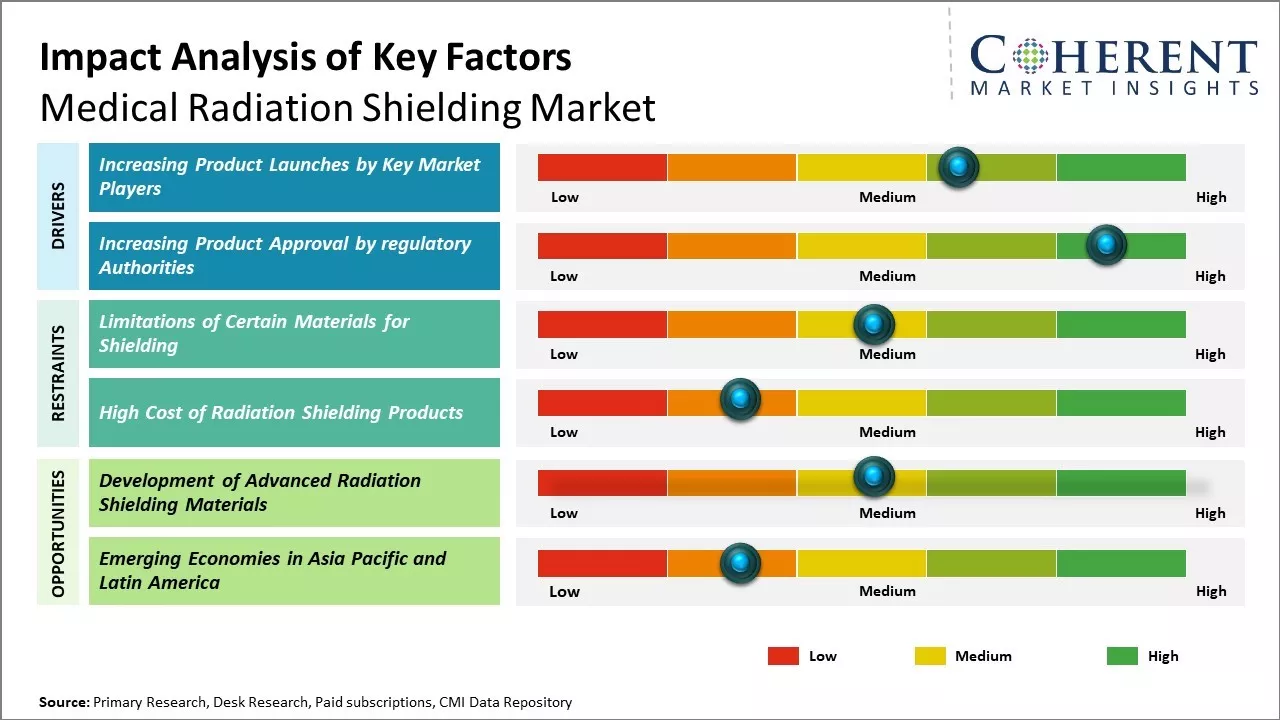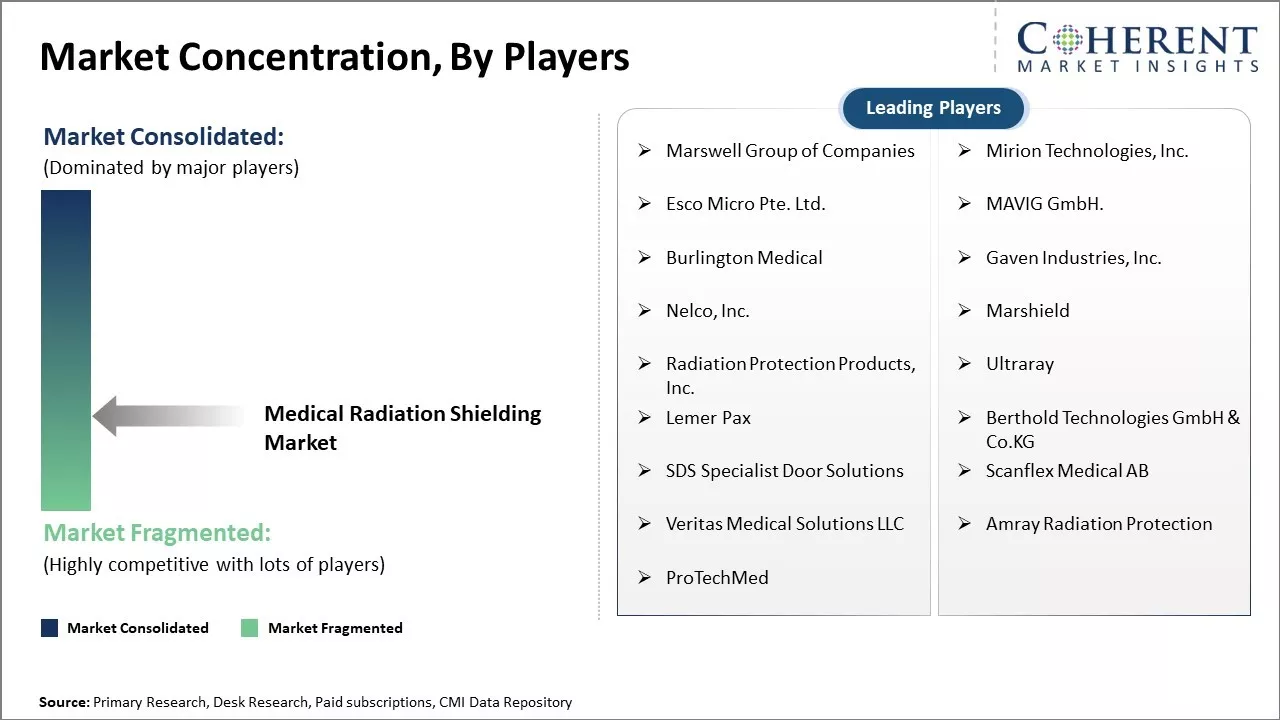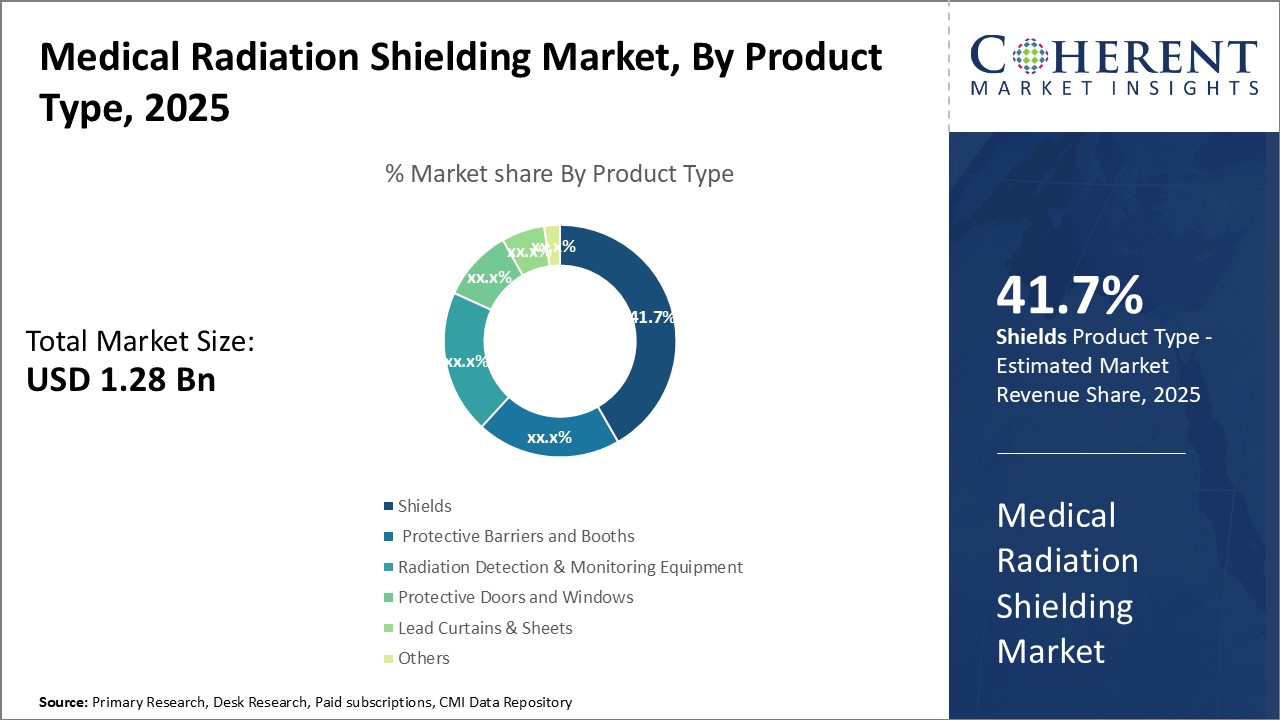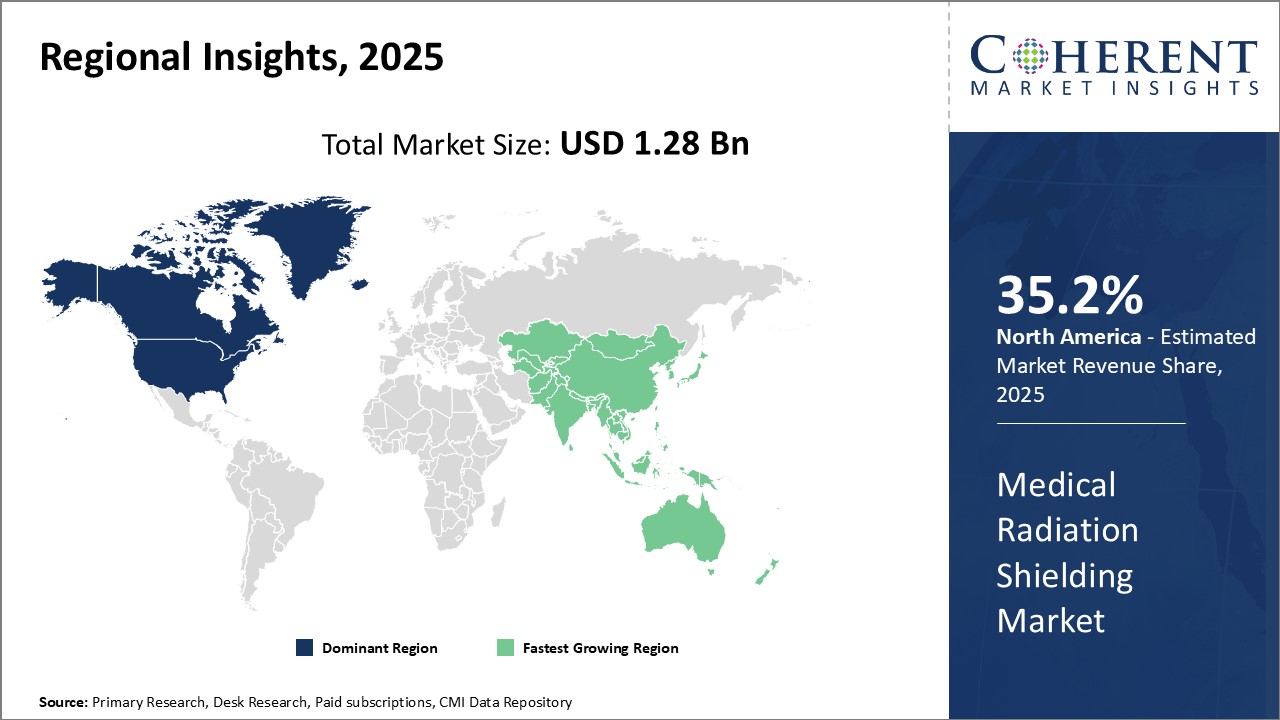Medical Radiation Shielding Market Size and Trends
Global medical radiation shielding market is estimated to be valued at USD 1.28 Bn in 2025 and is expected to reach USD 1.80 Bn by 2032, exhibiting a compound annual growth rate (CAGR) of 5.0% from 2025 to 2032.

Discover market dynamics shaping the industry: Download Free Sample
Increasing number of new cancer cases and rising adoption of nuclear medicine and radiation therapy for diagnosis and treatment is expected to boost demand for medical radiation shielding products. Growing investments and expansion of healthcare infrastructure in emerging markets is can also drive the market growth. Various initiatives by governments and healthcare organizations towards the prevention and cure of diseases is further expected to drive the market growth. However, the strict regulations regarding the disposal of lead-lined materials and increasing demand for eco-friendly shielding products can hamper the market growth during the forecast period.
Increasing Product Launches by Key Market Players
Increasing adoption of organic growth strategies such as product launches by key market players is expected to drive the global medical radiation shielding market growth over the forecast period. For instance, in February 2023, SDS Specialist Door Solutions, a manufacturer of specialist doorsets for demanding environments, launched Shield door lead-lined, x-ray doors for healthcare field that protects the demanding and challenging environments within hospital and radiology facilities.
Market Concentration and Competitive Landscape

Get actionable strategies to beat competition: Download Free Sample
Increasing Product Approval by regulatory AuthoritiesIncreasing product approvals by regulatory authorities is expected to drive the market growth over the forecast period. For instance, in April 2022, Radiaction Medical Ltd., a medical device company, announced that it had received approval from U.S. Food and Drug Administration for shield system in the U.S. The company had completed a US$ 10 million round of financing led by current investors- InnovaHealth Partners. The amount will be used to launch Radiaction's Shield System in the U.S. and to further commercialize in Europe.
Key Takeaways from Analyst
Global medical radiation shielding market growth is driven by rising incidence of chronic diseases and cancer that boosts demand for advanced medical imaging technologies. Growing affordability and availability of CT scans, X-rays, and other diagnostic imaging equipment in developing regions can also drive the market growth. Evolving regulations around radiation safety mandates the use of adequate shielding materials in all medical facilities, thus, offering opportunities for the market growth.
High investment costs for radiation shielding materials can hamper the market growth. Designing complex shielding solutions for large hospitals and clinics requires substantial upfront costs. Limited reimbursements for shielding products in certain countries also restrain the market growth.
North America dominates the medical radiation shielding market currently due to regulatory support and early technology adoption. However, Asia Pacific is poised to emerge as the fastest growing regional market. This can be attributed to rising healthcare investments, increasing penetration of medical insurance, and growing medical tourism industry in countries like India and China.
Market Challenge – Development of Advanced Radiation Shielding Materials
The limitations of certain materials for radiation shielding can hamper the medical radiation shielding market growth. Traditional shielding materials like lead have weaknesses that cannot be ignored. While lead provides excellent protection from radiation, it is extremely heavy and costly. Setting up lead radiation barriers and curtains requires robust infrastructure that not all healthcare facilities may have. It also poses occupational hazards during installation and maintenance due to its high density. Lead emits toxic fumes if burned or melted, which can have dangerous consequences in the event of a fire. The limitations and drawbacks of current radiation shielding solutions makes it difficult for healthcare organizations, especially those in developing countries and rural areas, to set up adequate protective measures as per international radiation safety standards. For instance, according to the World Health Organization, over 45% of medical facilities in Africa lack properly shielded radiography rooms due to constraints of material access and budget. These risks exposing staff and patients to radiation dangers. With growing health awareness, people now question the lack of sufficient safety layers more than before. Therefore, the need for innovative shielding materials that can overcome present shortcomings while meeting diverse requirements can hamper the market growth.
Market Opportunity – Development of Advanced Radiation Shielding Materials
The development of advanced radiation shielding materials provides tremendous opportunity for medical radiation shielding market growth. Radiation therapy is a critical component of cancer treatment, but current shielding materials only provide limited protection. With advancements in treatment techniques that use more targeted and higher doses of radiation, there is an increased need for materials that can safely shield sensitive tissues and organs near the treatment area better than existing solutions. New materials being researched have the potential to revolutionize radiation shielding for medical use. Scientists are working to engineer composites with enhanced attenuation properties to further reduce radiation transmission and scatter. Some promising research utilizes arrangements of high atomic number metals, custom particle structures, and plastic matrix composites infused with additional shielding fillers. These advanced designs allow for thinner and lighter shields that achieve the same or better protection compared to current thick lead aprons and barriers. The flexibility and conformability of new materials may also enable more ergonomic shield designs tailored for each patient's unique anatomy.

Discover high revenue pocket segments and roadmap to it: Download Free Sample
Insights, By Product Type: Personalizing Protection- The Dominance of Shields in Medical Radiation ShieldingProduct Type segment is sub-segmented into shields, protective barriers and booths, radiation detection & monitoring equipment, protective doors and windows, lead curtains & sheets, and others. Shields sub-segment is estimated to hold 41.7% of the market share in 2025, owing to their ability to customize protection according to specific radiation therapy requirements. Shields allow clinicians to precisely define the boundaries of a radiation field and shield sensitive organs located near the treatment site. These are available in different shapes, sizes and materials like lead, vinyl or tungsten to suit individual patient anatomies and radiation dosimetry parameters. Compared to other products like protective barriers and booths, shields provide a targeted solution requiring less material to achieve protection. This makes them more cost effective for blocking scattered radiation during diagnostic and therapeutic procedures. Shields can also be temporarily installed and quickly repositioned or removed as needed during a patient's radiation therapy process. Their flexible, tailored design allows for personalization that better ensures safety and comfort compared to standardized one-size-fits-all barriers. The customizability of shields can drives its widespread adoption in radiation oncology departments and medical imaging facilities.
Insights, By Application: Maximizing Protection in High Radiation Environments
Application segment is sub-segmented into radiation therapy shielding and diagnostic shielding. Radiation Therapy Shielding sub-segment is estimated to hold 56.7% of the market share in 2025, owing to higher radiation dosage present. Radiation therapy involves exposing malignant tumors to precise, high doses of radiation to destroy cancer cells while sparing surrounding healthy tissues. This requires robust shielding of all surfaces not included in the planned treatment volume. Compared to diagnostic procedures that utilize lower radiation quantities over briefer periods, radiation therapy necessitates materials and barrier designs able to withstand much greater exposure without degradation. Products optimized for radiation therapy shielding contain ultra-dense materials like vulcanized rubber or alloys that can barrier high energy beams for extended therapies. These also feature permanent, compartmentalized construction suitable for stationary installation in dedicated vaults. The pressing need to shield medical staff and shield delicate electronics from damaging scatter in radiation therapy departments underscores the prominence of solutions customized for withstanding higher radiation intensities.
Insights, By End User: Centralized Demand from Hospitals
End User segment is sub-segmented into hospitals, ambulatory surgical centers, others. The hospitals sub-segment is estimated to hold 43.3% of the market share in 2025, as cancer is predominantly treated in centralized, dedicated oncology facilities. Hospitals employ the most radiation generating equipment and treat the highest volume of patients receiving therapies like external beam radiotherapy, brachytherapy, nuclear medicine and interventional radiology procedures every day. The infrastructure and resources required to safely deliver these complex services necessitates comprehensive shielding integrated throughout radiation treatment areas, waiting rooms, hallways and radiation safety equipment storage locations. In contrast, ambulatory surgical centers see episodic, lower throughput radiology needs better met with smaller, modular shielding solutions. Other end users experience less demand for permanently installed tunnel, maze and room shielding tailored for housing linear accelerators and radiotherapy vaults. The preeminent role hospitals play in cancer diagnosis and therapy cements their position as the primary end user in medical radiation shielding market.
Regional Insights

Need a Different Region or Segment? Download Free Sample
North America remains the dominant region in the global medical radiation shielding market and is estimated to hold 35.2% of the market share in 2025. The U.S. has a large and developed healthcare industry, with a growing emphasis on advanced medical technologies and equipment using radiology. As radiology usage increases, so does the need for radiation shielding products to ensure safety standards are met. Major North American shielding product manufacturers such as Larson Electronics and Gaven Industries, Inc. have well-established operations catering to domestic demand.
Asia Pacific region is the fastest growing medical radiation shielding market. Rapid economic expansion in countries such as China and India has boosted overall healthcare investments and infrastructure development. With growing patient volumes, medical institutions are compelled to invest in radiation safety equipment to comply with emerging regulatory norms. The sizable untapped demand coupled with affordable cost of setting up manufacturing facility in Asia has spurred global market participants to focus on the region. Rising export activity from Asian nations to developed markets also indicates their growing proficiency. Local manufacturers are offering cost-effective alternatives, benefiting from low-cost skilled labor and favorable business conditions. Governments additionally support the medical technology sector recognizing its potential.
Market Report Scope
Medical Radiation Shielding Market Report Coverage
| Report Coverage | Details | ||
|---|---|---|---|
| Base Year: | 2024 | Market Size in 2025: | USD 1.28 Bn |
| Historical Data for: | 2020 To 2024 | Forecast Period: | 2025 To 2032 |
| Forecast Period 2025 to 2032 CAGR: | 5.0% | 2032 Value Projection: | USD 1.80 Bn |
| Geographies covered: |
|
||
| Segments covered: |
|
||
| Companies covered: |
Marswell Group of Companies, Mirion Technologies, Inc., Esco Micro Pte. Ltd., MAVIG GmbH., Burlington Medical, Gaven Industries, Inc., Nelco, Inc., Marshield, Radiation Protection Products, Inc., Ultraray, Lemer Pax, Berthold Technologies GmbH & Co.KG, SDS Specialist Door Solutions, Scanflex Medical AB, Veritas Medical Solutions LLC, Amray Radiation Protection, ProTechMed |
||
| Growth Drivers: |
|
||
| Restraints & Challenges: |
|
||
Uncover macros and micros vetted on 75+ parameters: Get instant access to report
Medical Radiation Shielding Industry News
- In February 2023, SDS Specialist Door Solutions, a manufacturer of specialist doorsets for demanding environments, launched Shieldoor lead-lined, x-ray doors for healthcare field that protects the demanding and challenging environments within hospital and radiology facilities
- In April 2022, Radiaction Medical Ltd., a medical device company focused on radiation protection in the interventional cardiology and electrophysiology sectors, announced that it had completed a US$ 10 million round of financing led by current investors- InnovaHealth Partners. The Funding will be used to launch Radiaction's Shield System in the U.S. and to further commercialize in Europe.
- In March 2022, TVM Capital Life Science, a venture capital firm, invested USD 13 million in Egg Medical Inc., a medical device company commercializing technologies to reduce scatter radiation exposure during interventional angiographic, to overcome the plague interventional cardiology - radiation scattering during X-ray-guided treatments. The radiation is contained in the company's Eggnest XR product, which substitutes the patient mattress on the X-ray table with a carbon fiber platform with inbuilt radiation shielding.
- In February 2022, Radiation Medical Ltd. announced a new partnership with Mazowiecki Hospital's acquisitions Interventional Cardiology section in Ostroleka, Poland. Through the company's ground-breaking fully-automated shielding technology, the hospital got the first installed system in Europe to safeguard interventional cardiologists and medical staff from the fatal effects of X-ray radiation exposure
*Definition: Medical radiation shielding market covers products that are used to shield people from the harmful effects of radiation exposure in medical settings. This includes protective barriers, curtains, protective apparel, and lead-lined materials that are installed or worn in areas with X-ray machines, CT scanners, nuclear medicine equipment and other devices that emit radiation during medical procedures and tests. The goal of these shielding products is to protect both medical professionals and patients from overexposure to radiation to lower health risks.
Market Segmentation
- Product Type Insights (Revenue, USD Bn, 2020 - 2032)
- Shields
- Protective Barriers and Booths
- Radiation Detection & Monitoring Equipment
- Protective Doors and Windows
- Lead Curtains & Sheets
- Others
- Application Insights (Revenue, USD Bn, 2020 - 2032)
- Radiation Therapy Shielding
- Diagnostic Shielding
- End User Insights (Revenue, USD Bn, 2020 - 2032)
- Hospitals
- Ambulatory Surgical Centers
- Others
- Regional Insights (Revenue, USD Bn, 2020 - 2032)
- North America
- U.S.
- Canada
- Latin America
- Brazil
- Argentina
- Mexico
- Rest of Latin America
- Europe
- Germany
- U.K.
- Spain
- France
- Italy
- Russia
- Rest of Europe
- Asia Pacific
- China
- India
- Japan
- Australia
- South Korea
- ASEAN
- Rest of Asia Pacific
- Middle East
- GCC
- Israel
- Rest of Middle East
- Africa
- South Africa
- North Africa
- Central Africa
- North America
- Key Players Insights
- Marswell Group of Companies
- Mirion Technologies, Inc.
- Esco Micro Pte. Ltd.
- MAVIG GmbH.
- Burlington Medical
- Gaven Industries, Inc.
- Nelco, Inc.
- Marshield
- Radiation Protection Products, Inc.
- Ultraray
- Lemer Pax
- Berthold Technologies GmbH & Co.KG
- SDS Specialist Door Solutions
- Scanflex Medical AB
- Veritas Medical Solutions LLC
- Amray Radiation Protection
- ProTechMed
Share
Share
About Author
Manisha Vibhute is a consultant with over 5 years of experience in market research and consulting. With a strong understanding of market dynamics, Manisha assists clients in developing effective market access strategies. She helps medical device companies navigate pricing, reimbursement, and regulatory pathways to ensure successful product launches.
Missing comfort of reading report in your local language? Find your preferred language :
Transform your Strategy with Exclusive Trending Reports :
Frequently Asked Questions
EXISTING CLIENTELE
Joining thousands of companies around the world committed to making the Excellent Business Solutions.
View All Our Clients
